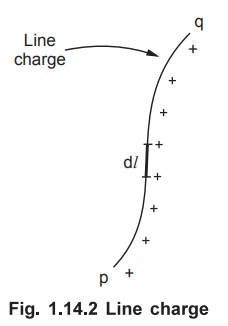Electromagnetic Theory: Unit I: (a) Vector Analysis
Types of Integral Related to Electromagnetic Theory
Line, Surface, Volume
• In electromagnetic theory a charge can exist in point form, line form, surface form or volume form. Hence while dealing with the analysis of such charge distributions, the various types of integrals are required. These types are,1. Line integral 2. Surface integral 3. Volume integral.
Types of
Integral Related to Electromagnetic Theory
AU:Dec.11, May-15
•
In electromagnetic theory a charge can exist in point form, line form, surface
form or volume form. Hence while dealing with the analysis of such charge
distributions, the various types of integrals are required. These types are,
1. Line integral
2. Surface integral
3.
Volume integral.
1. Line Integral
•
A line can exist as a straight line or it can be a distance travelled along a
curve. Thus in general, from mathematical point of view, a line is a curved path in a space.

•
Consider a vector field ![]() shown in the Fig. 1.14.1. The curved path shown
in the field is p - r. This is called a path of integration and corresponding integral
can be defined as,
shown in the Fig. 1.14.1. The curved path shown
in the field is p - r. This is called a path of integration and corresponding integral
can be defined as,
 ...(1.14.1)
...(1.14.1)
...
Using definition of dot product
where dl
= Elementary length
•
This is called line integral of ![]() around the curved path L. It represents an integral of the tangential component
of
around the curved path L. It represents an integral of the tangential component
of ![]() along the path L.
along the path L.
•
The curved path can be of two types,
i)
Open path as p-r shown in the Fig. 1.14.1.
ii)
Closed path as p-q-r-s-p shown in the Fig. 1.14.1.
•
The closed path is also called a contour.
The corresponding integral is called contour
integral, closed integral or circular integral mathematically
defined as,

•
This integral represents circulation of
the vector field ![]() around the closed path L.
around the closed path L.
•
If there exists a charge along a line as shown in the Fig. 1.14.2, then the
total charge is obtained by calculating a line integral.
 ... (1.14.3)
... (1.14.3)
where
ρL - Line charge density i.e. charge per unit length (C/m)

Key Point :
In evaluating line integration, the ![]() direction is assumed to be always
positive and limits of integration decide the sign of the integral.
direction is assumed to be always
positive and limits of integration decide the sign of the integral.
2. Surface Integral
•
In electromagnetic theory a charge may exist in a distributed form. It may be
spreaded over a surface as shown in the Fig. 1.14.3 (a). Similarly a flux may
pass through a surface as shown in the Fig. 1.14.3 (b). While doing analysis of
such cases an integral is required called surface
integral, to be carried out over a surface related to a vector field. For a
charge distribution shown in the Fig. 1.14.3 (a), we can write for the total
charge existing on the surface as,

where
ρS
= Surface charge density in C/m2
dS
= Elementary surface
•
Similarly for the Fig. 1.14.3 (b), the total flux crossing the surface S can be
expressed as,

where ![]() = Unit vector normal to the surface S
= Unit vector normal to the surface S
•
Both the equations (1.14.4) and (1.14.5) represent the surface integrals and mathematically it becomes a double integration while solving the
problems.
•
If the surface is closed, then it defines a volume and corresponding surface
integral is given by,
 ..
(1.14.6)
..
(1.14.6)
•
This represents the net outward flux of vector field ![]() from surface S.
from surface S.
Key Point :
1. The closed surface defines a volume. 2. The surface integral involves the
double integration procedure mathematically.
3. Volume Integral
•
If the charge distribution exists in a three dimensional volume form as shown
in the Fig. 1.14.4 then a volume
integral is required to calculate the total charge.
•
Thus if ρv is the volume charge density over a volume v then the
volume integral is defined as,
= ...(1.14.7)
...(1.14.7)
Where
dv = Elementary volume

Ex. 1.14.1 Show that over the closed surface
of a sphere of radius b  = 0 AU
: May-15, Marks 6
= 0 AU
: May-15, Marks 6
Ans. :
The
sphere is shown in the Fig. 1.14.5. The radius is b ans unit vector normal ti
the surface is ![]() .
.

But ![]() varies with both θ and ϕ hence it is necessary to express unit vector
varies with both θ and ϕ hence it is necessary to express unit vector ![]() in rectangular co-ordinate system. Refering section 1.13.4,
in rectangular co-ordinate system. Refering section 1.13.4,

Review Question
1. Explain in detail
line, surface and volume integrals of vector functions. AU : Dec.-11, Marks
16
Electromagnetic Theory: Unit I: (a) Vector Analysis : Tag: : Line, Surface, Volume - Types of Integral Related to Electromagnetic Theory
Related Topics
Related Subjects
Electromagnetic Theory
EE3301 3rd Semester EEE Dept | 2021 Regulation | 3rd Semester EEE Dept 2021 Regulation
